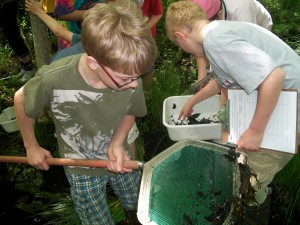Beyond Eco-Footprints: Using the STEM Process

Originally appears in the Summer 2013 issue
WHY DO environmentally-themed lessons often come with a full serving of guilt? One way in which this happens is through the use of an “Ecological Footprint” quiz that demonstrates to students how big their environmental impact is by asking a series of questions that indicate how many resources he/she uses. The student is presented with a score at the end, usually represented in the “number of earths” that it would take if everyone in the world lived the way he/she does.
What do students take away from doing an activity like this? even if you take the quiz as an environmental “angel”, you’ll find that it is impossible to reduce your footprint to much less than two “earths”. As acknowledged on many of the sites that offer footprint quizzes, a portion of your footprint is due to the fact that, if you live in countries like the United States, we have infrastructure and an economy that is based primarily on fossil fuels. Consequently, students are often left frustrated and unsure of what to do, since the situation feels somewhat hopeless.
In order to avoid the tendency towards what David Sobel termed “ecophobia”, where students feel overwhelmed with bad environmental news and subsequently distance themselves even more from the natural world, we decided to take the ecological footprint idea local, and teach students techniques for collecting their own “footprint” about their local ecosystem. In this article, we describe how taking a place-based approach to the ecological footprint not only improved students’ content knowledge but also provided new models of collaboration between grades and the ability for students to feel empowered to make a measurable difference in their community.
To view the photo-rich magazine version, click here.
If you are not already a subscriber, please subscribe to read the full article
Cornelia Harris is the Education Program Leader at the Cary Institute of Ecosystem Studies in Millbrook, NY, where she creates curriculum, leads professional development programs, and works with students of all ages to connect them with the ecosystems around us. Alan Berkowitz is the Head of the Education Program at the Cary Institute, where he leads several education research programs and professional development programs. He has been developing curriculum for students to learn ecosystem ecology for over 25 years. Kim Notin and Megan McLean both contributed to this article while working at the Cary Institute. Kim is now the Community Development and Fundraising Director for Association TAKH, a French organization working to reintroduce the Przewalski horse to its native range in Mongolia. Megan now teaches an arts and science education program in Boston, Massachusetts.
You can see Scorecards from two years of the project by visiting the Rhinebeck School District website, www.rhinebeckcsd.org , and we have included one part of the Scorecard from 2011 (Fig. 2). We want to thank the Rhinebeck Science Foundation for funding this project, and all of the teachers, students, parents, and administrators in the Rhinebeck School District for all their support and hard work over the last three years.
Leave a Reply
You must be logged in to post a comment.





